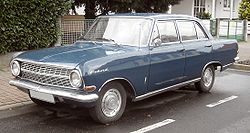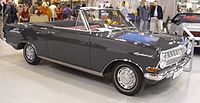Opel Rekord A.
| Opel | |
|---|---|
|
Opel Rekord (1963-1965)
|
|
| Record A | |
| Production period: | 03 / 1963-07 / 1965 |
| Class : | upper middle class |
| Body versions : | Sedan , coupe , station wagon |
| Engines: |
Petrol engines : 1.5-2.6 liters (40-74 kW) |
| Length: | 4512 mm |
| Width: | 1696 mm |
| Height: | 1405-1534 mm |
| Wheelbase : | 2639 mm |
| Empty weight : | 970-1110 kg |
| Previous model | Opel Rekord P2 |
| successor | Opel Record B |
The Opel Rekord A is a passenger car model of the upper middle class of the Adam Opel AG in Rüsselsheim . It was presented in March 1963 as the successor to the Opel Rekord P2 . With him, Opel also introduced the labeling of successor models of all vehicle types produced by letters in the order of the alphabet (A, B, C, etc.).
Its successor was the Rekord B , which appeared in August 1965 and was only marginally changed and equipped with newly developed engines, but was only built for just under a year.
Model history
General
The Rekord A appeared in March 1963 as a stylistically modernized and larger successor to the Rekord P2, which was successful at home and abroad. Opel changed the initial model designation Opel Rekord R3 or Rekord R3 , which was still in the papers of the very early vehicles, to Rekord A and led the labeling of subsequent models of all vehicle types with letters in the order of the alphabet (A, B, C, etc. .) a. However, like its predecessor Rekord P2, the lettering “Olympia” was still on the glove compartment.
It had a large, smooth-surfaced and sober, but elegant body in the style of the 1962 Chevrolet II ; because the body line was designed in the General Motors Design Center in Warren, Michigan . However, the designers in Rüsselsheim were also involved in designing the coupé.
Body versions
The Rekord A, the interior of which was more modern than its predecessor, was available as a two- and four-door notchback sedan , a three-door station wagon ("CarAVan"), a coupé and a delivery van (CarAVan without rear side windows). The station wagons and delivery vans were only available with three doors.
Upon request, there was also a convertible version based on the coupé, which was converted by the bodywork companies Deutsch in Cologne and Autenrieth in Darmstadt.
Opel Rekord Cabriolet from German
Engines and gears
The in-line four - cylinder engines - with a choice of 1.5 liter or 1.7 liter displacement and an output of 55, 60 or 67 hp (40, 44 or 50 kW) - were based on the Opel Olympia engine from 1937. This pre-war design included side camshaft , hanging valves and four-bearing crankshaft received their last and highest performance level in the record A. Although it had a reputation for good durability, it was no longer technically up-to-date and its development potential was exhausted. The successor Rekord B (from 1965) received newly designed CIH engines with an overhead camshaft.
The Rekord L-6, available from June 1964, with the 100 hp (74 kW) 2.6-liter in-line six-cylinder (based on the pre-war design of the Opel Super 6 from 1937) is considered the forerunner of the Opel Commodore . This was only available as a sedan and coupe. The L-6 was, together with the Kapitän / Admiral / Diplomat A, the first Opel car model with a 12-volt system. The engine block of the six-cylinder in-line engine placed a heavy load on the front axle, so that the steering was correspondingly difficult to move when stationary and when maneuvering, which occasionally even led to accidents (the steering wheel slipped out of the hand when cranking). A power steering was not available; they were only available in the upper-class models of the Opel KAD A series. At the time, automatic steering assistance was considered a luxury.
The sedan and station wagon were available with a fully synchronized three or four-speed gearbox and steering wheel gearshift, depending on requirements ; the coupé had the four-speed gearbox and center shift as standard .
The automatic clutch " Olymat " was optionally available with the three-speed gearbox (similar to the Saxomat from Fichtel & Sachs ). The system consisted of a centrifugal force-controlled starting clutch and a second clutch for changing gears, which meant that the clutch pedal was no longer required. The second clutch, activated by the negative pressure of the engine, was activated by an electrical contact on the gearshift lever. The chassis of the Rekord A corresponded to the standard of the 1960s: front independent wheel suspension on double wishbones with coil springs , rear rigid axle with semi-elliptical leaf springs and hydraulic telescopic shock absorbers all around. Drum brakes were standard ; Front disc brakes in conjunction with a dual-circuit brake system were available for a surcharge of DM 150.00 . The dual-circuit brake system with front disc brakes and brake booster was standard on the 2.6-liter model .
In the simplest version, the two-door sedan of the Rekord A cost DM 6,830, the coupé with a 2.6-liter engine DM 9,310.
From March 1963 to July 1965 a total of 887,304 Rekord A were produced.
Technical specifications
| Technical data for the Opel Rekord A 1963–1965 | ||||
|---|---|---|---|---|
| Opel record: | 1500 | 1700 | 1700 p | L-6 (1964/65) |
| Engine: | 4-cylinder in-line engine (four-stroke) | 6-cylinder in-line engine (four-stroke) | ||
| Displacement: | 1488 cc | 1680 cc | 2605 cc | |
| Bore × stroke: | 80 × 74 mm | 85 × 74 mm | 85 x 76.5 mm | |
| Performance at 1 / min: | 40 kW (55 PS) at 4500 |
44 kW (60 hp) at 4300 |
49 kW (67 hp) at 4400 |
74 kW (100 PS) at 4600 |
| Max. Torque at 1 / min: |
106 Nm at 2000-2600 |
120 Nm at 1800–2400 |
125 Nm at 2200-2900 |
181 Nm at 2400 |
| Compression: | 7.25: 1 | 8.0: 1 | 8.2: 1 | |
| Mixture preparation: | 36 mm downdraft carburetor Opel (license Carter Carburetor) | |||
| Valve control: | Overhead valves, bumpers and rocker arms (side camshaft, spur gears) | |||
| Cooling: | Water cooling | |||
| Transmission: | 3- or 4-speed gearbox (1700 S and L-6 only 4-speed gearbox), steering wheel or center shift |
|||
| Front suspension: | Independent suspension on double wishbones , coil springs | |||
| Rear suspension: | Rigid axle on 2 semi-elliptical longitudinal leaf springs with 3 (Caravan: 4) spring layers | |||
| Brakes: | hydraulically operated drum brakes, Ø 200 mm (caravan rear 230 mm) |
hydraulically operated drum brakes, Ø 200 mm (caravan rear 230 mm) On request: front discs, Ø 238 mm, rear drums, Ø 230 mm |
Front discs, Ø 238 mm, rear drums, Ø 230 mm | |
| Body: | Sheet steel, self-supporting | |||
| Track width front / rear: | 1321/1276 mm (L-6: 1325/1279 mm) | |||
| Wheelbase: | 2639 mm | |||
| Length: | 4512 mm | |||
| Empty weight: | 970-1135 kg | |||
| Top speed: | 130 km / h | 135 km / h | 140-144 km / h | 163-168 km / h |
| 0-100 km / h: | 23-25 s | 21-22 p | 17-18 s | 13-14 p |
| Consumption (l / 100 km): | 10.0-10.5 l normal | 10.0 l super | 12.0 l super | |
Remarks
- ↑ a b Eckhart Bartels, Rainer Manthey: Opel: Vehicle Chronicle Volume 2: 1952–1990. Podszun, Brilon 2012, ISBN 978-3-86133-620-4 , pp. 8/9 and 28/29.
- ↑ The change of the model name probably came because there was also a condom brand called R3 .
literature
- Werner Oswald : German Cars 1945–1975 . Motorbuch Verlag, Stuttgart 1975, ISBN 3-87943-391-7 , pp. 88-93







